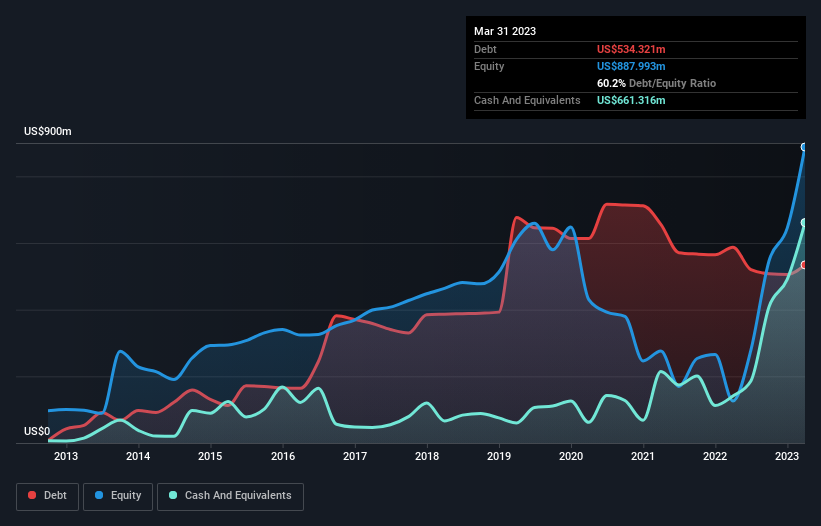- United States
- /
- Oil and Gas
- /
- NYSE:PARR
Par Pacific Holdings (NYSE:PARR) Seems To Use Debt Quite Sensibly
Howard Marks put it nicely when he said that, rather than worrying about share price volatility, 'The possibility of permanent loss is the risk I worry about... and every practical investor I know worries about.' It's only natural to consider a company's balance sheet when you examine how risky it is, since debt is often involved when a business collapses. Importantly, Par Pacific Holdings, Inc. (NYSE:PARR) does carry debt. But the real question is whether this debt is making the company risky.
Why Does Debt Bring Risk?
Generally speaking, debt only becomes a real problem when a company can't easily pay it off, either by raising capital or with its own cash flow. Part and parcel of capitalism is the process of 'creative destruction' where failed businesses are mercilessly liquidated by their bankers. However, a more frequent (but still costly) occurrence is where a company must issue shares at bargain-basement prices, permanently diluting shareholders, just to shore up its balance sheet. By replacing dilution, though, debt can be an extremely good tool for businesses that need capital to invest in growth at high rates of return. The first thing to do when considering how much debt a business uses is to look at its cash and debt together.
View our latest analysis for Par Pacific Holdings
What Is Par Pacific Holdings's Net Debt?
The image below, which you can click on for greater detail, shows that Par Pacific Holdings had debt of US$534.3m at the end of March 2023, a reduction from US$587.3m over a year. However, its balance sheet shows it holds US$661.3m in cash, so it actually has US$127.0m net cash.

How Healthy Is Par Pacific Holdings' Balance Sheet?
According to the last reported balance sheet, Par Pacific Holdings had liabilities of US$1.57b due within 12 months, and liabilities of US$867.1m due beyond 12 months. On the other hand, it had cash of US$661.3m and US$277.7m worth of receivables due within a year. So its liabilities total US$1.50b more than the combination of its cash and short-term receivables.
This deficit is considerable relative to its market capitalization of US$1.99b, so it does suggest shareholders should keep an eye on Par Pacific Holdings' use of debt. This suggests shareholders would be heavily diluted if the company needed to shore up its balance sheet in a hurry. While it does have liabilities worth noting, Par Pacific Holdings also has more cash than debt, so we're pretty confident it can manage its debt safely.
It was also good to see that despite losing money on the EBIT line last year, Par Pacific Holdings turned things around in the last 12 months, delivering and EBIT of US$830m. There's no doubt that we learn most about debt from the balance sheet. But ultimately the future profitability of the business will decide if Par Pacific Holdings can strengthen its balance sheet over time. So if you want to see what the professionals think, you might find this free report on analyst profit forecasts to be interesting.
Finally, while the tax-man may adore accounting profits, lenders only accept cold hard cash. While Par Pacific Holdings has net cash on its balance sheet, it's still worth taking a look at its ability to convert earnings before interest and tax (EBIT) to free cash flow, to help us understand how quickly it is building (or eroding) that cash balance. Over the most recent year, Par Pacific Holdings recorded free cash flow worth 66% of its EBIT, which is around normal, given free cash flow excludes interest and tax. This free cash flow puts the company in a good position to pay down debt, when appropriate.
Summing Up
Although Par Pacific Holdings's balance sheet isn't particularly strong, due to the total liabilities, it is clearly positive to see that it has net cash of US$127.0m. The cherry on top was that in converted 66% of that EBIT to free cash flow, bringing in US$549m. So we don't have any problem with Par Pacific Holdings's use of debt. The balance sheet is clearly the area to focus on when you are analysing debt. However, not all investment risk resides within the balance sheet - far from it. Case in point: We've spotted 2 warning signs for Par Pacific Holdings you should be aware of.
If, after all that, you're more interested in a fast growing company with a rock-solid balance sheet, then check out our list of net cash growth stocks without delay.
New: Manage All Your Stock Portfolios in One Place
We've created the ultimate portfolio companion for stock investors, and it's free.
• Connect an unlimited number of Portfolios and see your total in one currency
• Be alerted to new Warning Signs or Risks via email or mobile
• Track the Fair Value of your stocks
Have feedback on this article? Concerned about the content? Get in touch with us directly. Alternatively, email editorial-team (at) simplywallst.com.
This article by Simply Wall St is general in nature. We provide commentary based on historical data and analyst forecasts only using an unbiased methodology and our articles are not intended to be financial advice. It does not constitute a recommendation to buy or sell any stock, and does not take account of your objectives, or your financial situation. We aim to bring you long-term focused analysis driven by fundamental data. Note that our analysis may not factor in the latest price-sensitive company announcements or qualitative material. Simply Wall St has no position in any stocks mentioned.
About NYSE:PARR
Undervalued with moderate growth potential.
Similar Companies
Market Insights
Community Narratives




